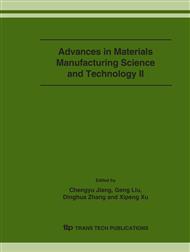p.129
p.133
p.137
p.141
p.145
p.149
p.153
p.157
p.161
A Novel Superfine Machining Technology Based on the Magnetorheological Effect of Abrasive Slurry
Abstract:
Based on the magnetorheological (MR) effect of abrasive slurry, this paper presents an innovative superfine machining method. In this technique, the particle-dispersed MR fluid is used as a special instantaneous bond to cohere abrasive particles and magnetic particles so as to form a dynamical tiny-grinding wheel. This tiny-grinding wheel can be used to polish the surface of brittle materials in millimeter or sub-millimeter scale. The characteristics of the machined glass surfaces examined by the scanning electron microscope (SEM) and the Talysurf roughness tester confirmed the effectiveness of the finishing technique. The machined surface with convex center and concave fringe demonstrates that the material removal process is dominated by the synergy of the applied pressure and the relative velocity between the abrasives and workpiece. In the case of glass finishing, the mode of material removal is found to be plastic, and controlled by the abrasive-wear mechanism.
Info:
Periodical:
Pages:
145-148
Citation:
Online since:
December 2006
Authors:
Price:
Сopyright:
© 2006 Trans Tech Publications Ltd. All Rights Reserved
Share:
Citation:


